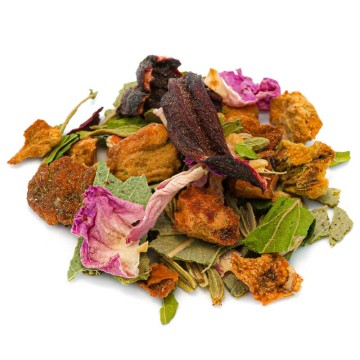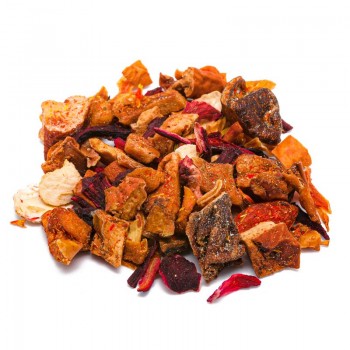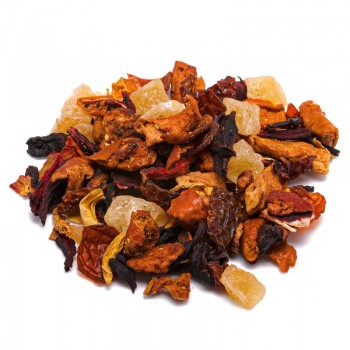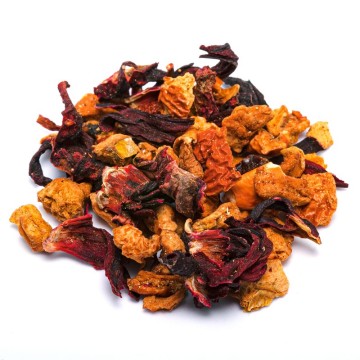This herbal tea combines the properties of various medicinal herbs and ingredients, with toasted licorice. The intense taste allows you to enjoy the infusion, which gives properties useful for calming irritation and inflammation of the airways.
It has a beneficial effect on some flu symptoms and in case of discomfort in the digestive system.
Toasted licorice: properties and benefits
The different components of the infusion enhance the virtues of licorice for our body. Toasted licorice gives this infusion properties known in herbal medicine as natural anti-inflammatories in case of sore throats, colds, irritations of the airways and headaches.
The active ingredient that soothes irritations is glycyrrhizin, an acid contained in licorice root with emollient, refreshing, decongestant and expectorant virtues. The active ingredient of glycyrrizic acid is famous for its sweet taste, used in pastry and herbal medicine. Its goodness is combined with its ability to provide expectorant properties in this infusion, suitable in case of cough and phlegm, sore throat or rhinitis. In ancient times, in oriental medicine, toasted licorice has always been preferred over untoasted licorice, because it seems to have greater natural anti-inflammatory qualities. Although roasted licorice contains less glycyrrhizin, the potency of the action is higher.
Furthermore, glycyrrhizin or glycyrizzina has diuretic and digestive properties which are also beneficial in protecting the digestive system. Licorice is known as a digestive food that counteracts gastrointestinal irritations. It fights gastroesophageal reflux, constipation and digestive difficulties (slow digestion, heaviness, bloating). Licorice root is also a food known for its purifying and diuretic qualities, which facilitate the well-being of the liver and kidneys, as well as the gastrointestinal tract. Its beneficial properties help to detoxify our body, even with a mildly laxative action. Among the other ingredients there is anise, which has expectorant qualities useful in case of colds and phlegm.
Together with fennel, with similar qualities, these ingredients amplify the properties of licorice. The best known active ingredient is anethole, which facilitates the action of contrasting the irritations of our body, and is useful against some bacteria. The taste of anise is also similar to that of licorice. Other useful elements such as expectorants and protective of the respiratory system are mint and dog rose. Mint implements a decongestant and balsamic action on the airways, which allows you to enhance the qualities of licorice. Facilitates the unblocking of the bronchi, in case of blockage. It is a fluidifying element of secretions such as mucus and phlegm, and is historically used in case of colds and coughs. For the respiratory system, the dog rose brings its properties to soothe colds, coughs, allergic rhinitis and sinusitis. It supports the immune system thanks to vitamin C and helps against migraines. The properties of elderberry flowers, present in the toasted licorice infusion, are also known.
They support perspiration during cold alterations, to expel toxins, and are used as emollients and expectorants in cases of irritation of the respiratory system. Blackberry leaves also promote well-being against colds, sore throats, nasal congestion, wet cough. They help in the herbal tea to balance the temperatures and calm the tissues damaged by the irritated and excessive mucous membrane. Calendula petals have an emollient effect on the oropharyngeal mucosa, calming redness, as do mullein flowers, peony petals and sunflower petals (they contain saponins and antioxidants useful for reducing cough symptoms). natural anti-inflammatory, useful for respiratory tracts irritated by phlegm secretions, such as in the case of bronchitis. In our infusion, the toasted licorice root is accompanied by numerous other elements, which are also useful for the digestive system. The mix contains raspberry leaves, apple pieces, wild strawberry leaves, lemon balm.
Origins and History of cultivation
Licorice is a plant native to western Asia and southern Europe, and today grows in many countries, as one of the most cultivated plants in the world. It is widespread above all in Russia, Spain, France, England, Germany, the Middle East and Asia. Licorice has been appreciated since ancient times in food, as well as for its ownmedicinal benefits considered, especially in oriental medicine as a source of strength, longevity and vitality. The black licorice we know today comes from the root of the plant, and was known to the Greeks as glykys (sweet) rhiza (root).
Licorice was already used thousands of years ago in China, where it is already mentioned in the oldest Chinese herbarium as a root to treat coughs, food poisoning and liver. The ancient Egyptians believed that it gave the deceased the ability to drive away evil spirits that approached the soul. In Tutankhamun's tomb, pieces of licorice were found in burial vessels. The Greek and Roman legionaries chewed the licorice root to quench their thirst during the marches, to calm stomach ache. In the Middle Ages it was famous among the monks who used it for bronchial infections, coughs and stomach ailments. Even in Napoleon's time, the French general kept it for digestive health and to calm the nerves on the battlefield. Once it arrived in America, the Sioux Indians chewed licorice root to relieve toothaches and to treat earache. Also in those years the modern sweet licorice was born, created in 1760 by the English apothecary George Dunhill. He used sugar and flour to dilute the medicinal licorice essence that he sold, and thus the licorice candy was born, with incredible success. Today it is known in many preparations, also as a flavoring for smoking products, drinks and desserts. The products we know, shiny and black, are obtained by working the licorice root, breaking it up, creating a paste from which the juice is extracted, boiled and transformed into a thick liquid. Roasted licorice, on the other hand, is typical of traditional Chinese formulations. It has been used above all for its alleged beneficial action on the heart in anti-arrhythmia function. The decoction of toasted licorice was used, in the yin and yang theory, to replenish the yin and activate the yang – today it is studied for the protection of endothelial cells and the activation of platelets. In our toasted licorice infusion it is present in a natural version with numerous other elements. Plant and flowers The licorice plant is Glycyrrhiza glabra, a perennial herb of the Leguminosae family.
It is known for its roots. To grow it requires deep, fertile and moisture-rich soil, and can even reach about 2 meters. Plant growth is initially slow, but once established, licorice can become a weed. The roots are harvested in autumn.
Other components are:
anise - Illicium verum, a tropical evergreen tree of the Schisandraceae family; the petals of Calendula officinalis is an annual and perennial plant, part of the Asteraceae family; raspberry leaves, of the Rubus idaeus L. plant, a fruit shrub of the Rosaceae family; dog rose is a plant that belongs to the Rosaceae family; the apple from the Malus domestica plant, belonging to the Rosaceae family; fennel from the botanical name Foeniculum vulgare, is a flowering plant of the Apiaceae (Umbelliferae) family; blackberry leaves, from the Rubus Fruticosus L. tree which belongs to the large Rosaceae family; the leaves of wild strawberries of the genus Fragaria, part of the Rosaceae family; the plantain or Plantago lanceolata is a perennial and spontaneous plant of the Plantaginaceae family; Sambucus flowers , a flowering plant belonging to the Adoxaceae family. The most common type is Sambucus nigra, also known as European elderberry or black elderberry. Melissa officinalis is an annual plant of the Lamiaceae family; sunflower petals, an annual plant Helianthus annuus belonging to the Asteraceae and native to North America; peony petals derive from the flowering plant of the genus Paeonia, the only genus of the Paeoniaceae family; mullein flowers or Verbascum thapsus, species of the Scrophulariaceae family; mint or Mentha, perennial plant of the Lamiaceae family widespread in many species, hybrids and varieties.
Nutritional values of roasted licorice infusion
This herbal tea contains several interesting antioxidants and phytochemicals such as glycyrrhizin, anethole, quercetin, acids and antioxidants. Licorice contains some vitamins and limited amounts of calcium, iron, phosphorus, potassium, magnesium and zinc.
How to use licorice and other ingredients in the infusion
The herbal tea is obtained by placing in a cup (250 ml), about 3-5grams the mixture of toasted licorice, with water at 100 °C. Leave to infuse for 10 to 12 minutes, before drinking the hot and emollient drink. Add honey or sugar, if desired.
Toasted licorice tea: side effects and contraindications
It is recommended to maintain the correct doses of this infusion, since the abuse of licorice can give rise to side effects. Its intake is not recommended for those suffering from hypertension, and its limited use is recommended for those who want to avoid an excessive increase in blood pressure. In some cases, excessive doses can give annoying side effects such as water retention, headache, vomiting, nervousness. Its use is not recommended for those suffering from renal insufficiency and diabetics - sweetening elements are present in the infusion.











 No reward points for this product.
No reward points for this product.















